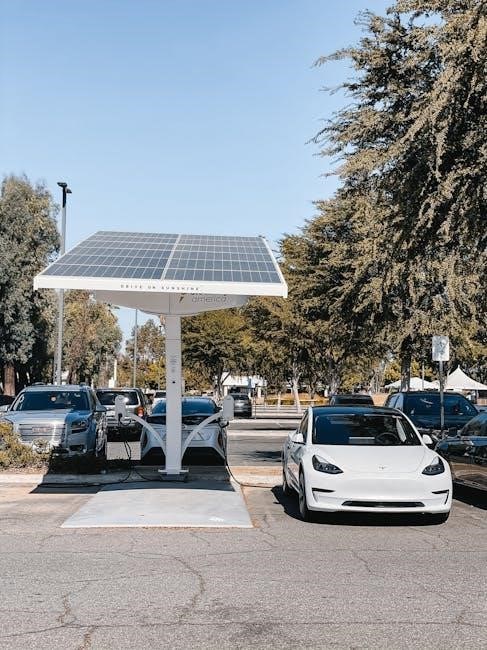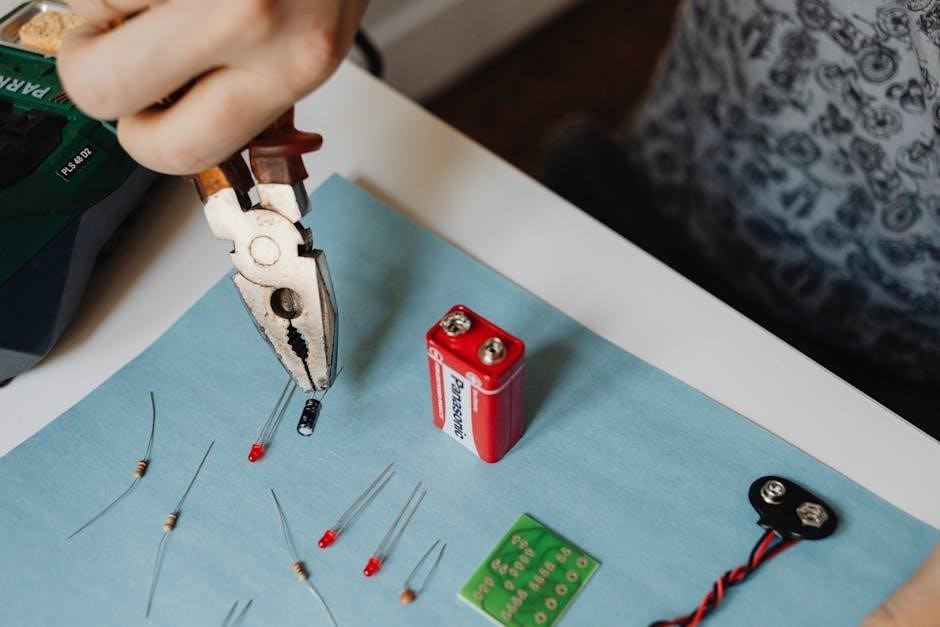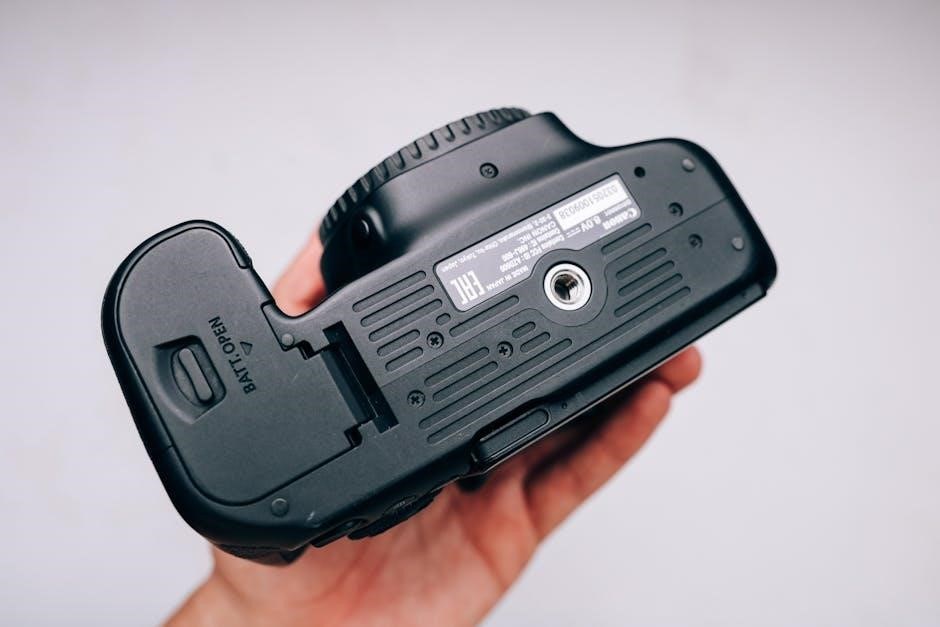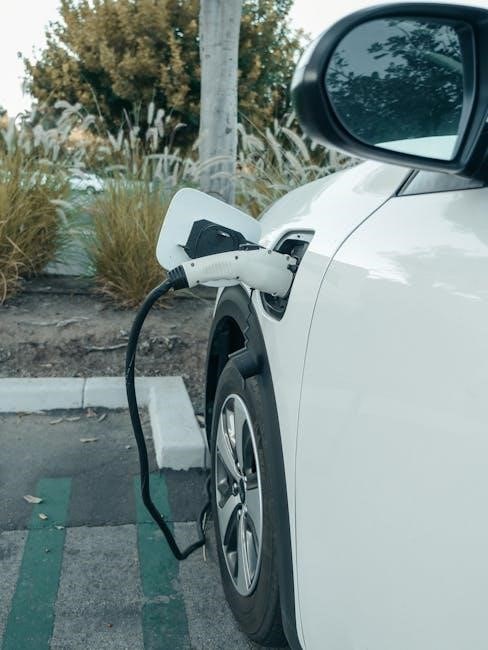The DieHard Battery Charger is a versatile, fully automatic charger designed for 6V and 12V batteries, featuring microprocessor control, engine starting, and battery testing with built-in safety protections;
Overview of the DieHard Battery Charger
The DieHard Battery Charger is a high-quality, versatile charging solution designed for both 6V and 12V batteries. It features microprocessor-controlled operation, ensuring efficient and safe charging. The charger is suitable for automotive, marine, and deep-cycle batteries, offering fully automatic functionality with built-in safety protections. With its user-friendly interface, it provides options for standard and rapid charging, making it ideal for home or light commercial use. The charger also includes advanced features like battery testing and engine starting capabilities, catering to a wide range of applications. Its robust design and reliable performance make it a trusted choice for maintaining battery health and extending lifespan.
Key Features and Applications
The DieHard Battery Charger boasts a range of innovative features, including fully automatic operation, microprocessor control, and compatibility with both 6V and 12V batteries. It serves as a versatile solution for charging automotive, marine, and deep-cycle batteries. The charger also functions as an engine starter, providing emergency starting power. Additional features include a built-in battery and alternator tester, ensuring comprehensive diagnostics. Its compact design and portability make it ideal for home use, small workshops, or roadside emergencies. Suitable for cars, trucks, boats, and tractors, this charger is a reliable tool for maintaining and restoring battery health across various applications.

Safety Precautions and Guidelines
Always keep the charger out of reach of children, avoid exposure to moisture, and never charge a frozen or damaged battery to ensure safe operation.
General Safety Rules
Always keep the charger out of reach of children and avoid exposing it to rain or snow. Never charge a frozen battery or overcharge, as this can cause damage or safety risks. Do not place the battery on top of the charger during operation. Wear protective gear, including gloves and safety glasses, when handling batteries. Ensure the charger is used in a well-ventilated area, away from flammable materials. Keep a source of fresh water and soap nearby for immediate cleaning in case of acid contact. Follow all safety rules and operating instructions carefully to ensure safe and effective charging.
Emergency Procedures and First Aid
In case of acid contact, immediately flush the affected area with fresh water and soap. For eye exposure, rinse thoroughly and seek medical attention. If electrical shock occurs, disconnect the power source and call emergency services. Never touch the victim until the power is off. Keep water and soap nearby for quick cleaning. If a battery ruptures, ventilate the area and avoid inhalation of fumes. Do not attempt to neutralize spilled acid with baking soda. Follow all first aid instructions carefully and seek professional help if needed. Always prioritize safety to prevent accidents during charging.

Understanding the Charger Components
The DieHard Battery Charger features a microprocessor for precise charging, an LCD display for real-time status, and durable connectors for secure battery connections, ensuring efficient and safe operation.
Main Controls and Indicators
The DieHard Battery Charger features a user-friendly interface with key controls and indicators. The selector switch allows choosing between 2-AMP and 10-AMP charge rates, while the ammeter displays the charging current. An LCD display provides real-time status updates, and LED indicators show charging progress, errors, or connection status. The charger also includes a mode selection button for switching between charging and engine start modes. These components ensure precise control and monitoring, helping users maintain safety and efficiency during the charging process. Proper use of these controls is essential for optimal performance and battery health.
Selector Switches and Charge Rate Settings
The DieHard Battery Charger features a 2-way selector switch to choose between 2-AMP and 10-AMP charge rates. The 2-AMP setting is ideal for deeply discharged batteries or when time allows for a slower, gentler charge. The 10-AMP setting provides faster charging for less depleted batteries. Properly selecting the charge rate ensures safe and efficient charging. Always match the charge rate to the battery’s condition and your time constraints. This feature enhances versatility, making the charger suitable for both 6V and 12V batteries. Refer to the manual for specific guidelines on charge rate selection and usage.

Charging Procedures
Connect the charger to the battery, ensuring correct polarity. Set the charge rate using the selector switch. Turn on the charger and monitor the progress. Always follow safety guidelines and manufacturer instructions for optimal charging.
Preparing the Battery for Charging
Before charging, ensure the battery is in a well-ventilated area, away from open flames or sparks. Turn off the charger and disconnect the AC power cord. Inspect the battery for cracks or damage; if damaged, do not charge. Clean the terminals with a wire brush to ensure good connections. Check the battery voltage using the charger’s built-in tester, if available. Verify the battery type (e.g., AGM, flooded, or gel) to select the correct charge mode. Remove any protective covers from the terminals and ensure the battery is at room temperature. Never charge a frozen battery. Follow the charger’s specific preparation guidelines for optimal results.
Charging the Battery In-Vehicle vs. Out-of-Vehicle
Charging the battery in-vehicle is convenient for quick boosts but requires careful connection to avoid electrical system interference. Out-of-vehicle charging is ideal for maintenance or deep discharges, allowing better control and safety. For in-vehicle charging, ensure the ignition is off and accessories are disconnected to prevent damage. When charging out-of-vehicle, place the battery on a stable, non-flammable surface and secure it to prevent movement. Always follow the charger’s guidelines for both methods to ensure safety and effectiveness. Proper ventilation is crucial in both cases to prevent hydrogen gas buildup. Never charge a frozen battery in either scenario.
Selecting the Correct Charge Rate (2-AMP vs. 10-AMP)
Selecting the correct charge rate is crucial for safe and efficient charging. The 2-AMP setting is ideal for slow charging, such as maintaining batteries or charging deeply discharged ones, and is safer for extended periods. The 10-AMP setting is designed for faster charging, suitable for quick top-ups or when time is limited. Always choose the 2-AMP rate for frozen or old batteries to prevent damage. For standard charging, start with 2-AMP and switch to 10-AMP if needed. Follow the charger’s guidelines to avoid overcharging, which can harm the battery. Proper rate selection ensures optimal performance and longevity of your battery.

Battery Maintenance and Care
Regular maintenance ensures battery longevity. Monitor charge levels, clean terminals, and store batteries in a cool, dry place. Avoid full discharge and overcharging, following guidelines for optimal care.
Monitoring Battery Health
Regularly monitoring your battery’s health is crucial for optimal performance. Check voltage levels using the charger’s built-in tester or a multimeter. Ensure terminals are clean and secure. Look for signs of wear, swelling, or corrosion. Maintain charge levels between 50% and 80% to prevent deep discharges, which can reduce lifespan. Store batteries in a cool, dry place away from direct sunlight. Use the DieHard charger’s diagnostic features to assess battery condition and identify issues early. Proper monitoring helps extend battery life and ensures reliable engine starting and electrical system performance.
Best Practices for Long-Term Storage
For long-term storage, store the battery in a cool, dry place away from direct sunlight and extreme temperatures. Charge the battery to 50-80% capacity before storage to prevent deep discharge. Avoid fully charging or leaving it completely drained. Use the DieHard charger’s maintenance mode to trickle charge and maintain optimal levels. Check voltage periodically and recharge as needed. Clean terminals and ensure connections are secure. Store the battery upright to prevent acid leakage. These practices help preserve battery health, prevent corrosion, and ensure reliable performance when needed. Always follow the charger’s guidelines for storage and maintenance.
Troubleshooting Common Issues
Identify and resolve common issues like error codes, charging problems, or unexpected alarms by referring to the troubleshooting guide in the DieHard Battery Charger manual.
Diagnosing Charging Problems
Diagnosing charging issues with your DieHard Battery Charger involves checking error codes, alarms, and irregular behavior. Common problems include overcharging, incorrect charge rate settings, or poor battery connections. Ensure the charger is properly grounded and the AC power cord is securely plugged in. If the charger fails to turn on, verify the outlet is functioning. For battery-specific issues, check for loose terminals or corrosion. Refer to the error code chart in the manual to identify specific malfunctions. Resetting the charger or allowing it to cool down may resolve some issues. Always consult the troubleshooting section for detailed guidance and solutions to restore proper charging functionality.
Understanding Error Codes and Alarms
The DieHard Battery Charger features error codes and alarms to indicate charging issues. Common codes include overcharging, low battery voltage, or incorrect polarity connections. The charger’s LED indicators (red, green, or flashing) signal specific statuses. For example, a flashing red light may indicate a high battery temperature or a faulty connection; Refer to the error code chart in the manual for precise meanings. If an alarm sounds, disconnect the charger and check connections. Ensure the battery is not frozen or damaged. Reset the charger if necessary and follow manual guidelines for resolving errors. Always consult the troubleshooting section for detailed solutions.
Frequently Asked Questions (FAQs)
Common queries include charge rate selection, battery compatibility, and troubleshooting. Users often ask about 2A vs. 10A settings and resolving charging issues effectively.
Common User Queries and Solutions
- Q: Which charge rate should I use (2A vs. 10A)?
A: Use 2A for slow charging and maintaining batteries. Use 10A for faster charging when time is limited. - Q: Can I charge a completely dead battery?
A: Yes, but start with the 2A setting to avoid damage. Avoid overcharging. - Q: What types of batteries are compatible?
A: The charger works with 6V and 12V lead-acid batteries, including flooded, AGM, and gel types. - Q: Why isn’t the charger turning on?
A: Check the power cord connection and ensure the battery is properly connected. Consult the manual for troubleshooting.
These solutions address common concerns and ensure safe, effective use of the DieHard Battery Charger.
The DieHard Battery Charger is a reliable and versatile tool for maintaining and charging automotive batteries. Its user-friendly design, combined with advanced features like microprocessor control and multiple charge rates, makes it suitable for both professionals and DIY enthusiasts. By following the guidelines and safety precautions outlined in the manual, users can ensure optimal performance, prolong battery life, and maintain safety. Whether for routine maintenance or emergency starting, the DieHard Battery Charger delivers consistent results, making it a valuable addition to any garage or workshop.
